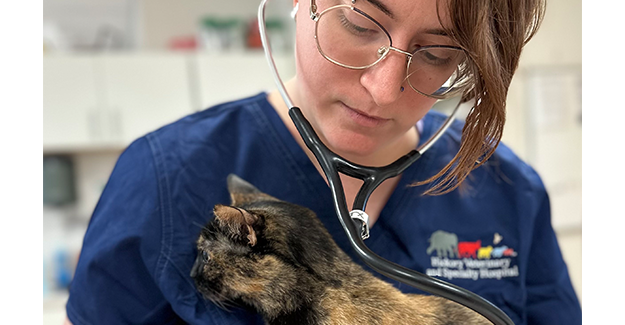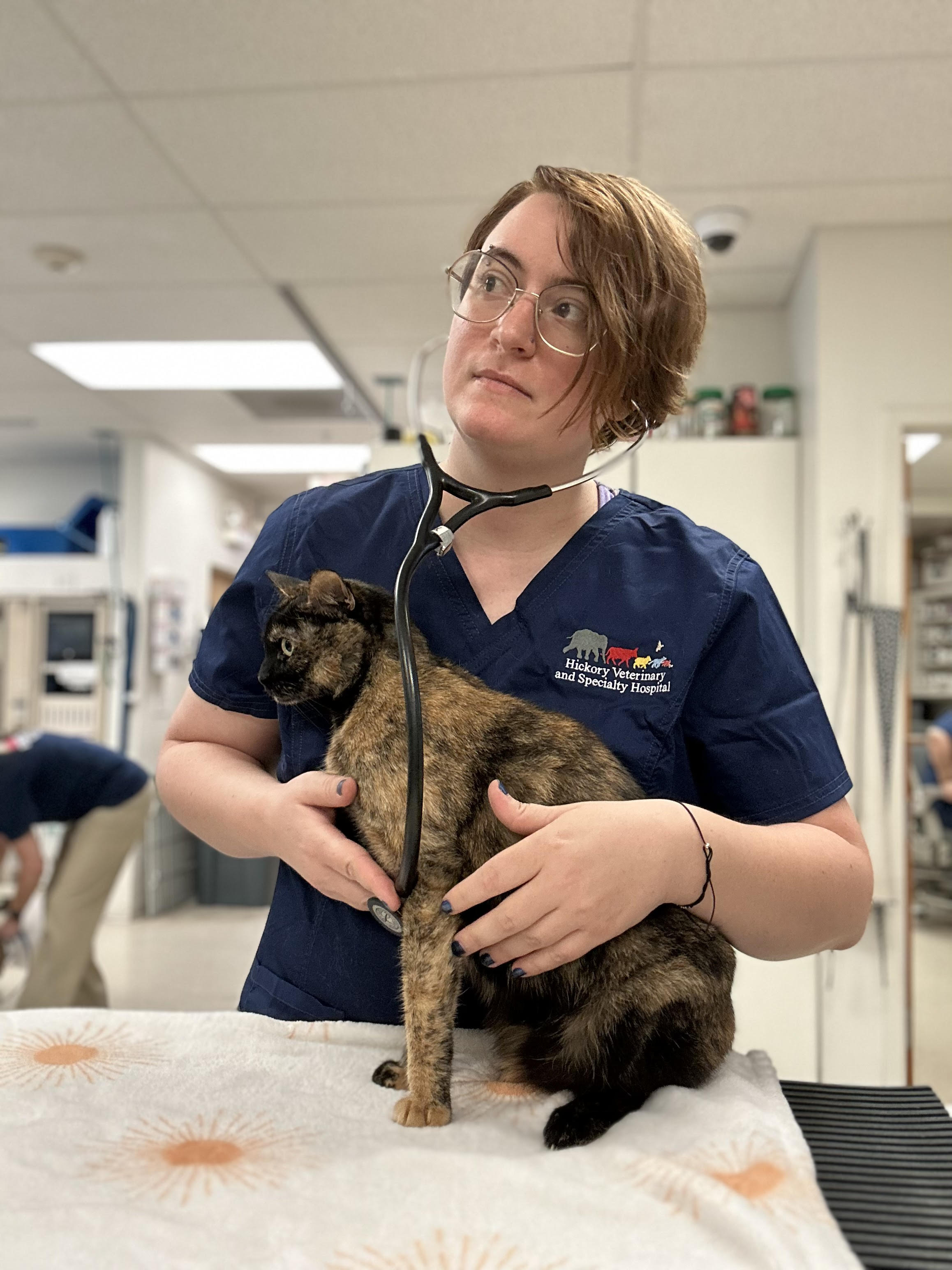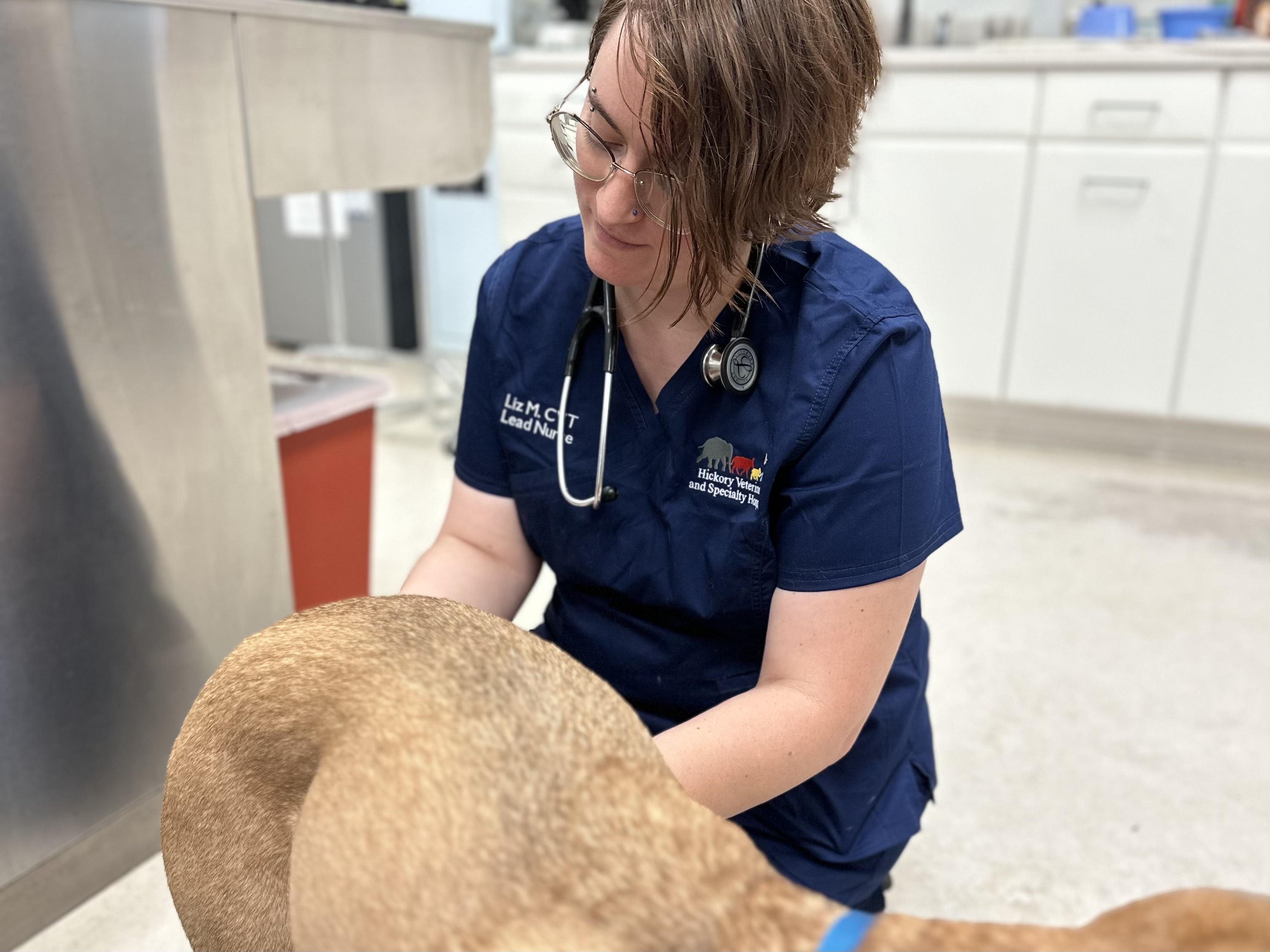Vet Teams IRL: Elizabeth Musgreave, CVT

Vet med is a small world and inevitably someone you worked with at a clinic 10 years ago comes back into your orbit. This was the case when I was contacted by my good friend Alicia Carr, a VTS (Emergency and Critical Care), who I used to work with back in the day when I was a lil’ babe just learning the ways of specialty medicine.
Alicia contacted me to say she has been working with a technician who is an absolute rockstar and needed a feature in our Vet Med IRL series. Alicia is a badass vet tech and mom, and I know if she says someone is legit, there must be a good reason.
In this month’s article, we get to know CVT and cat enthusiast Elizabeth Musgreave.
‘A good pitty smile, a fluffy tail wag . . . and all the kitty beans!’
Tasha McNerney (TMc): What are some things you love about your job in veterinary medicine?
Elizabeth Musgreave (EM): The number one thing I love about working in veterinary medicine is seeing all of the cats and dogs that I can help feel better while helping the owners change their pets’ lives for their betterment.
I love a good pitty smile, a fluffy tail wag, a nudge from a nose or nuzzle to be pet more, and seeing all the kitty beans that need to be eaten! I love making those unique connections with my patients. Personally, I could not imagine my life without a cat.


A memorable case: 'Henry' the poodle mix
TMc: Same. I am a ‘crazy cat lady’ to my core! Working in practice, has a particular case stuck with you over the years?
I've been at Hickory Veterinary and Specialty Hospital for a little over 10 years now, and I have seen a lot of interesting cases. But I will never forget a middle-aged poodle mix—we'll call him Henry—who was successfully diagnosed with copper storage disease.
He ended up staying in the hospital for at least a week. He was one of my first big intensive cases. He definitely challenged my technical skills and made me a better technician. He wasn't a typical breed to develop this disease and unfortunately, he did start to have a serious clotting disorder while hospitalized. He stayed in our oxygen cage for a few days, and everyone was worried if he would make it out of the hospital due to all of the complications.
But thankfully, he received the correct diagnosis. I am extremely proud and happy to say he did make it back to his loving family who had visited him every day. It's crazy to think a small change to a therapeutic copper-restriction diet would make all the difference for him.
Henry's case challenged me due to the intensive care he needed: From utilizing the oxygen cage; continuously monitoring his vitals and blood pressure; dealing with compromised vessels and needing to ascertain blood samples; and learning how to build upon our client relationship (you always want to be able to have a rapport with the family).
A long stay in the hospital is not easy for anyone, and getting to know what the pet is used to can be most valuable. Something as simple as knowing how he/she likes to have their meals in a certain bowl can make a difference.
Teamwork makes the dream work
TMc: Why do you think it's important to approach veterinary medicine as a team?
EM: It's vital to work as a team! We all have our strengths and weaknesses, and coming together for the same goal will balance these things out for the benefit of our patients. We also all do different tasks in order to accomplish this: from the assistant finding that perfect bed for a certain patient to the technician appropriately monitoring the patient to catch subtle changes, to the veterinarian being able to give the correct diagnosis. All of these roles contribute to the recovery of a patient.
The Fear-Free difference
TMc: What improvements or advancements have you seen in the field of veterinary medicine over the years?
EM: I think one of the most important advancements in the field has been Fear-Free accreditation. Here at Hickory Veterinary and Specialty Hospital we use Fear-Free care, and it does work!
I know change is hard, but by making a few small changes to your approach, it can really help us give the best care to our patients. For instance, we offer a "comfort pack" consisting of a few doses of gabapentin and trazodone with Fear-Free information for the owners to premedicate at home. It can help us to facilitate something as simple as a Fear-Free nail trim to make it easier for the patient to induce anesthesia.
It allows us to treat and care for animals that, before, had not been able to receive the gold standard of care because of their temperament.
Sometimes we can actually get to the point of not utilizing any medications because the patient starts to make the connection that they do not need to be fearful anymore. Stress and anxiety are directly related to healing and recovering, so let's try to lessen those things.
Technicians are often the first to notice
TMc: What are some hopes you have for the veterinary technician profession going forward?
EM: My hope is that technicians are eventually recognized for what we do. Technicians are some of the animals' biggest advocates. We are the first to notice if they seem more painful, hungry, anxious, depressed, or brighter.
We do everything from bathing patients to monitoring them under anesthesia, and there is so much in the middle! My hope is for the term “veterinary technician” to be more well-known. There are a lot of people that don't understand just how many skills you must have to be a veterinary technician, or they simply don't know what a veterinary technician means.
CVTs, RVTs, and LVTs work hard for those titles. I hope those titles become more commonplace in veterinary hospitals so we can elevate the standard of care for animals.
Photos courtesy of Elizabeth Musgreave
Tasha McNerney BS, CVT, CVPP, VTS (Anesthesia and Analgesia) is a certified veterinary technician and certified veterinary pain practitioner who works closely with the IVAPM to educate the public about animal pain awareness. McNerney has authored numerous articles on anesthesia and analgesia topics for veterinary professionals and pet owners.
Disclaimer: The views expressed, and topics discussed, in any NEWStat column or article are intended to inform, educate, or entertain, and do not represent an official position by the American Animal Hospital Association (AAHA) or its Board of Directors.
NEWStat Interesting/unusual Client communication Columnists Patient care



